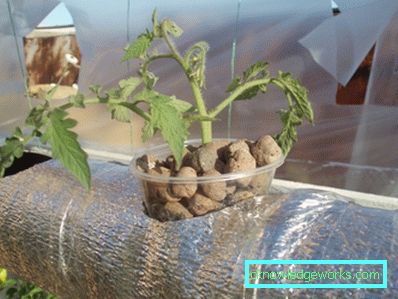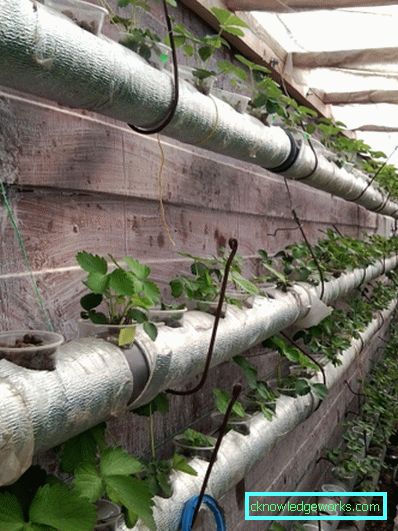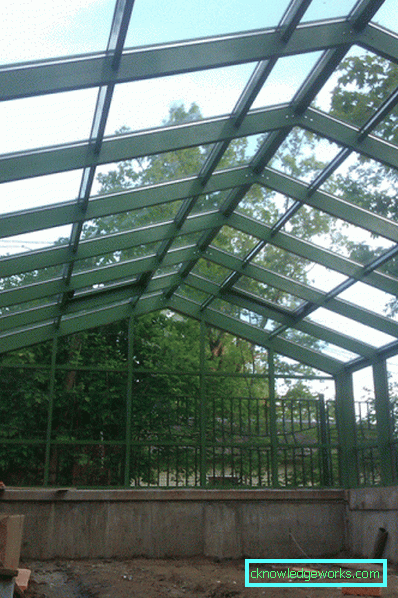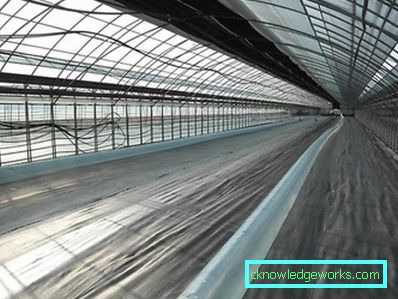Year-round greenhouse

Types of year-round greenhouses
Greenhouse for year-round cultivation can be of different types.
- The most widely used devices are glass and polycarbonate. The side walls of such greenhouses are warmed, because they are built in two layers, between which an air layer is supposed to protect against cold. Experienced gardeners prefer polycarbonate due to its high strength. The roof of such a greenhouse will not collapse even in case of heavy snowfall. A hand-made device from the above materials requires good heating, but it is quite possible to do without additional lighting, because the light penetrates well through the transparent walls and the roof.
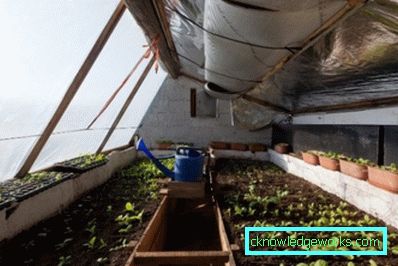
- Another type of year-round greenhouse is a mixed construction with foam concrete walls and a polycarbonate roof. Here it will not be necessary to supply the device with heavy-duty heating, since the foam concrete retains heat well. However, additional lighting will have to be installed, since such a greenhouse is only illuminated through a transparent roof, and its walls create a shadow. If there are no lighting fixtures in the building, then only shade-loving crops can be grown in it.
- The least popular for all-season use is a semi-underground greenhouse. It is a pit over which the roof rises. The advantage is that this device is below the level of freezing of the earth, maintaining the temperature in it will not be difficult, and will have to spend money only on lighting. Disadvantages are expressed in the fact that such a greenhouse can be built only where there is no groundwater. In addition, for additional security, it is necessary to provide the structure with waterproofing equipment.
Making a transparent greenhouse do it yourself
In view of the fact that the year-round polycarbonate greenhouse is the most popular, it is first necessary to figure out how to build this particular greenhouse model. If you plan to grow vegetables and greens in it in the winter, then it is best to install the structure on the foundation and place boxes with earth in it. Effective heating will be infrared lamps.
So, in order to build a polycarbonate greenhouse with your own hands, you will need a foundation, in addition you need to build two-layer walls. You will also need foam blocks, concrete, materials for insulation, pipes made of steel for the erection of the frame, cellular polycarbonate, mounting tools, a shovel, a circular saw and materials for facing.

It is not necessary to build a very strong foundation, as the device that will stand on it is not very heavy. For the base, dig a 50 cm pit, and then around the perimeter, form the base of the foundation using foam blocks. Elements are fastened with cement.
Make sure that the height of the base of the foam blocks turned out to be at least 10 cm above the ground level.
Next, you need to lay the bottom layer of sand in 20 cm, then from pebbles or rubble in 25 cm. This will be the basis for the floor, which you can do at your discretion from concrete or tile. Then go to the construction of the frame. In order to protect the vegetables in the greenhouse all year round, it is best to install a steel frame. It is strong enough and will withstand any winter bad weather.
If you can not buy a finished frame, you can build it with your own hands from unnecessary steel pipes that you have. If you purchased a ready-made base, you only have to assemble it. This is not very difficult: it will only be necessary to fasten the elements with nuts according to the enclosed instructions.
When building a frame with your own hands out of pipes, calculate the position of the rods so that the polycarbonate sheets have to be cut as little as possible. The dome of the greenhouse should be arcuate. However, without serious skills in the construction of greenhouses, it is almost impossible to make polycarbonate bend with the right hands, therefore it is best to build a gable dome.
In order not to be mistaken in which side to put polycarbonate, find the manufacturer's marking on the sheets. Be careful, because the error will lead to low stability of the greenhouse and will deprive it of thermal insulation, as a result of which the cultivation of vegetables will not be crowned with success.
Polycarbonate is fixed in two layers so that an air gap forms between them, which will protect the plants from the cold. Connect with special thermal washers. Mounting should start with the inner layer. If small gaps form at the joints, seal them with a sealant the same as polyurethane foam. It is also recommended to cover the greenhouse from the inside with a thermo-insulating foil coating for the winter.
Proceed to the heating system and finishing is necessary only after installing the frame and polycarbonate plates.
Year-round mixed-type greenhouse: stages of construction
To grow vegetables all year round, you can also build a greenhouse of a mixed type, that is, a greenhouse, whose walls are made of foam blocks, and the roof is transparent (glass or foam carbonate). As mentioned earlier, polycarbonate is much more convenient, since it is easier to work with it.
Growing up in a greenhouse is good, but ... the first step is to build a foundation. A very good option would be a strip foundation that goes into the ground by 50 cm. Before you start building a greenhouse, you need to let the foundation stand for at least 3 months to avoid subsidence with the greenhouse ready.

After this period, you can build foam block walls. They must be at least 2 m high so that a person can stand at full height in a greenhouse. Inside the wall should be finished with plaster. Then you can take up the roof. First form the metal rafters. As soon as a strong frame is equipped, start using polycarbonate.
In the case of a mixed-type greenhouse, it should be fixed in a special way: the first layer of polycarbonate is placed on metal rafters. Metal profiles are fastened on top of it, and then the second layer.
On such a roof, the snow does not melt in winter, since the heat loss of the mixed greenhouse is virtually absent. It means that growing in it will give good results, and you can simply clear the snow from the roof if necessary.
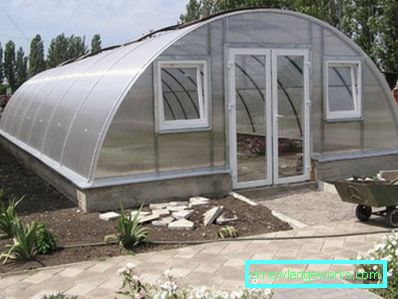
After laying the polycarbonate roof, the joints between the sheets and the walls need to be equipped with a plastic ridge, and from the inside sealed with assembly foam. As in the previous case, with a transparent greenhouse, the inside of the walls should be covered with foil foil for additional thermal insulation. Outside the wall is painted with white paint. This is done so that the light repelled from the surface.

Heating greenhouses
One of the most important moments in the construction of the greenhouse is heating. This statement is quite reasonable, since plants, as is known, without heat can neither grow nor produce a crop. Unfortunately, it is not always possible to carry out heating in the greenhouse from the house itself. However, there are other methods of supplying greenhouse heating. The most common and convenient are electric radiators, infrared radiation, convectors, heaters.

Infrared devices will be a reasonably economical and efficient option. They not only provide plants with heat, but also provide a source of light that is also necessary for the growth of vegetable crops. It is reasonable to place the infrared equipment under the ridge so that light and heat are evenly distributed throughout the space in the greenhouse.
Simple year-round greenhouse (video)
Greenhouse lighting
Another important point is the lighting. Additional light is especially necessary in the winter season, since the light day in winter is very short and is not enough for plants for normal development. The best options for an additional lighting system are fluorescent lamps or LEDs because of their efficiency. Such lamps must be installed directly above the boxes with plants so that the seedlings grow in a straight upward direction.
Thus, following the advice, you will be able to build a reliable structure without any problems, and then the greenhouse will serve you all year round, providing delicious fresh vegetables.
Gallery: year-round greenhouses (15 photos)



